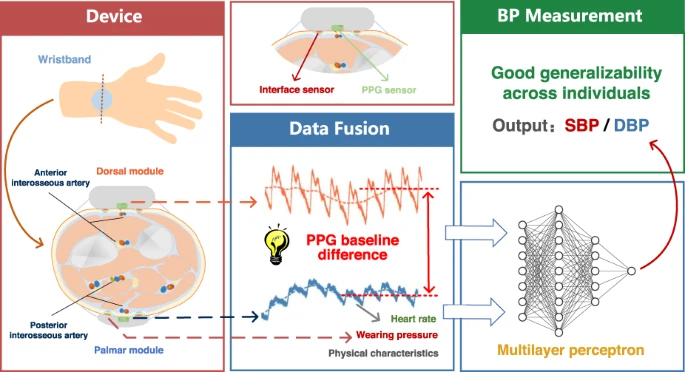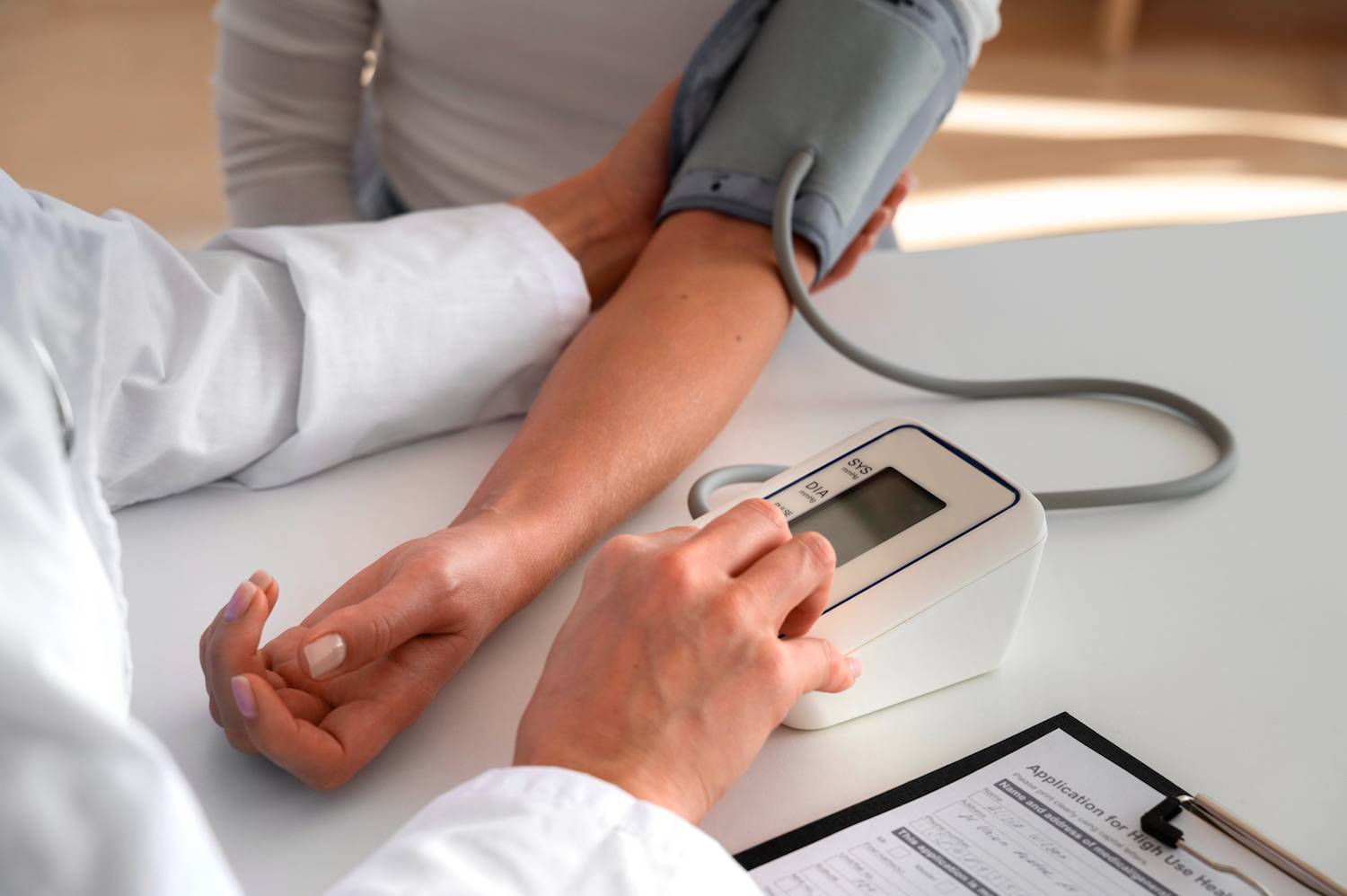Hypertension has long been known to be a causative factor for a multitude of medical ailments. Hypertension has further been noticed to have significantly increased in recent years, posing a public health concern. While medical costs and inconvenience may deter potential patients from seeking frequent blood pressure monitoring, new advances in wearable medical devices have made it possible to measure blood pressure cheaply and conveniently from the comfort of one’s home. Tsinghua University, China, researchers designed a wearable device and a novel blood pressure measurement technique for continuous monitoring. The wearable device can be generalized across individuals and has considerable promise in personal healthcare applications.
Introduction
Hypertension is a medical ailment that has received significant scrutiny over the past few decades. A condition wherein the arterial blood pressure is higher than normal over a long period of time, it has been implicated as a significant risk factor in conditions such as heart failure, strokes, and atrial fibrillation, among others. Lifestyle and genetic factors greatly increase the risk of having high blood pressure, and it has been noted to be a cause of premature death all over the world.
We can see that the measurement of blood pressure regularly can have significant positive impacts by letting individuals know about irregularities in a timely and convenient manner. Wearable medical devices also eliminate other factors in the mismeasurement of blood pressure, including human error and blood pressure variability in various settings. Ambulatory monitors have been developed for this purpose, which can be used to measure blood pressure at certain intervals, but even these cannot provide continuous measurement of blood pressure and prove to be inconvenient to the user since they often need to be used at a frequency of once every 15 to 30 minutes, and interrupt the progression of daily life.
Issues in Existing Methods for Wearable Blood Pressure Monitoring Devices
As such, wearable instruments for measuring blood pressure have become much more popular among those at risk of high blood pressure. These use a variety of methods, from volume clamping to tonometry, as well as newer data-driven methods like PTT (pulse transit time), PWV (pulse wave velocity), and PWA (pulse wave analysis). However, volume clamping is an inconvenient method that may be uncomfortable for consistent use, and tonometry’s sensitivity necessitates frequent calibrating, which may not be feasible for many. The newer methods show a lack of generalization across a given population, being unable to achieve AAMI standards of acceptable error and standard deviation without calibration for each subject. However, such calibration is infeasible on a larger scale and is not practical.
A team of researchers has now proposed a novel method for measuring blood pressure, which solves these issues by performing continuous monitoring of blood pressure while avoiding the problem of lack of generalizability that characterized earlier methods. The device in question is a wristwatch that contains dual photoplethysmography (PPG) sensors worn across the wrist to detect the pulse, as well as custom interface sensors that can detect skin temperature and wearing pressure. The various signals from the sensors are used as input in a machine learning algorithm that can calculate an estimated blood pressure measurement continuously. The presence of two PPG sensors on the device can help eliminate variability in measurement caused due to differences in individuals and how they wear the device, thus increasing accuracy. The measurement of contact pressure, as well as skin temperature, further helps in informing the final value of blood pressure detected.

During circulation, blood volume changes in a cyclical manner according to the heart’s beating – this change in volume can show important information about the individual’s cardiovascular system, like blood flow, cardiac function, and microcirculation, among others, and is known as the “volume pulse wave” and can be detected with a PPG sensor. The PPG signal comprises an AC and a DC component, with the latter being larger. The DC signal measures the magnitude of volume per beat, which measures parameters like vascular elasticity and resistance. The AC component reflects variability in peripheral resistance and cardiac ejection, among others. As factors like skin color and contact pressure can mess with the signals from PPG sensors, these were also accounted for in the final estimation. It is known that contact pressure and differing skin colors, tissue, and muscle volume can account for variability, not just between individuals but also for the same individual due to differences in wear conditions.
During the study, it was realized that blood flow in the anterior and posterior interosseous arteries (on the front and back of the wrist) is somewhat synchronized, and the difference in the blood flow between them can be used to measure the stroke volume. When measured on an individual, this provides an accurate representation of the necessary cardiovascular information. Additionally, as skin color, muscle, and tissue tend to be similar since they are on the same wrist, they will have similar effects on the final estimation, which can be easily eliminated.
The device was tested on individuals by having their blood pressure measured by the device and a commercially available monitor. Eight features from the PPG signals, four features from the interface sensors, and additional information about each subject’s characteristics (like age, weight, height, and gender) were combined to estimate the final blood pressure value. Eighteen subjects were evaluated this way repeatedly to collect a total of 309 data sets. The results of the blood pressure estimates were compared to estimates that used the PWA, or pulse waveform analysis, method with machine learning. It was demonstrated that the estimates given by the latter method were much more scattered than estimates provided by the former. The new method also has a lower computational load than the PWA method, making it more feasible for wearable medical devices.
Conclusion
Some components of the device, such as the sensor system structure and algorithm performance, will need to be further studied and improved upon. Different scenarios, such as exercising and sweating, will also need to be studied. However, the comparatively simple design and ease of use make this an attractive proposition for patients who suffer from high blood pressure or may otherwise want continuous monitoring of their blood pressure levels. The low computational load will also make this method much more feasible than others with higher loads from a practical perspective. The use of machine learning algorithms to successfully predict blood pressure may pave the way for further applications for machine learning in biomedical devices. This device has exciting implications for the future of wearable medical devices.
Article source: Reference Paper
Learn More:
Sonal Keni is a consulting scientific writing intern at CBIRT. She is pursuing a BTech in Biotechnology from the Manipal Institute of Technology. Her academic journey has been driven by a profound fascination for the intricate world of biology, and she is particularly drawn to computational biology and oncology. She also enjoys reading and painting in her free time.
















